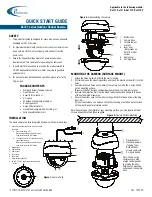Silicon Imaging , Inc. 2004 Page 7 of 39 Company Confidential
CameraLink Camera Signal
This section provides definitions for the signals used in the Camera Link interface. The standard Camera Link cable
uses a MDR 26-pin connector (3M Part# 10226-6212VC)provides the following signaling:
•
Video Data (4 Pairs using 28:4 Mux, 24 Video, 4 Control)
•
Camera control signals (1 Pair)
•
Serial communication (2 Pairs)
Video Data
The 24 bit image data (2 words x 12 bit) and 4 control bits are transmitted over only 4 differential pairs using a 28:4
multiplexer (National Semiconductor DS90CR285 Channel Link device). The Four enable signals are defined as:
• FVAL—Frame Valid (FVAL) is defined HIGH for valid lines.
• LVAL—Line Valid (LVAL) is defined HIGH for valid pixels.
• DVAL—Data Valid (DVAL) is defined HIGH when data is valid.
• Spare— A spare has been defined for future use.
All four enables are provided on the camera, via the Channel Link chip. The unused data bits are tied to a known
value by the camera. For more information on image data bit allocations, see page 11,
CameraLink Base
Configuration Bit Assignment Configuration.
Communication
Two LVDS pairs have been allocated for asynchronous serial communication to and from the camera and frame
grabber. Cameras and frame grabbers should support at least 9600 baud. These signals are
• SerTFG—Differential pair with serial communications to the frame grabber.
• SerTC—Differential pair with serial communications to the camera.
The serial interface operates at 9600 baud, one start bit, one stop bit, no parity, and no handshaking. For
applications requiring high serial throughput, such as real time windowing update at over 200FPS, the camera can
support a serial link mode at 57kbs (not specified in CameraLink spec). The frame grabber serial communication
must be set to match this speed.


















